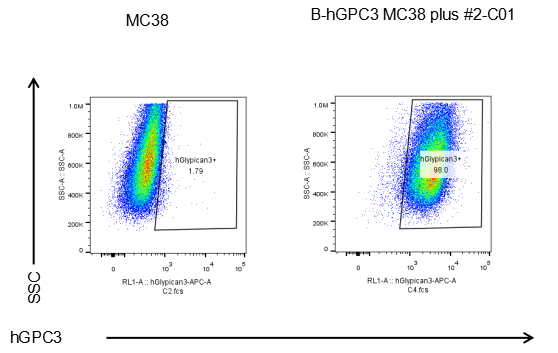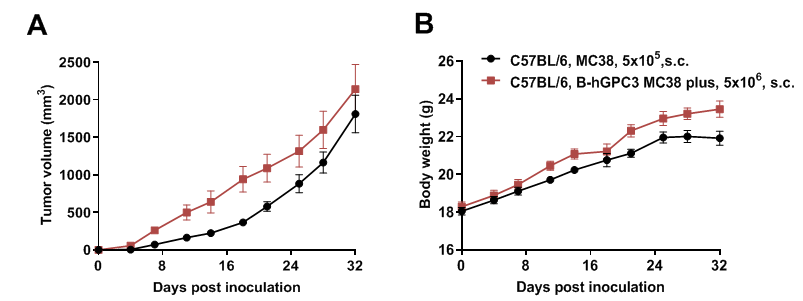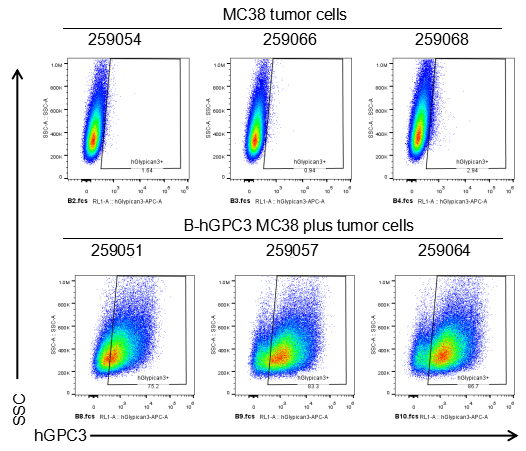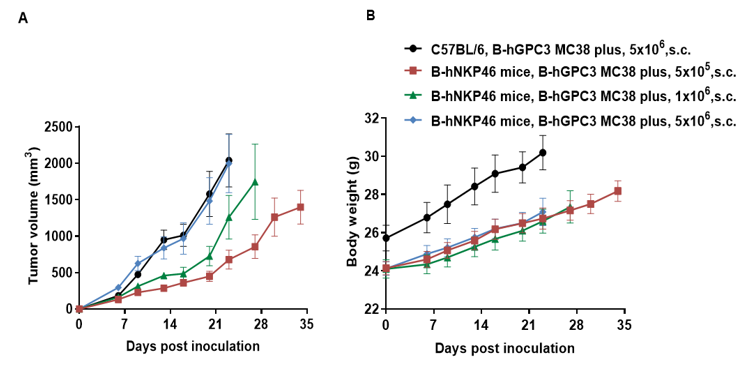Common name
|
B-hGPC3 MC38 plus
|
Catalog number
|
322039
|
|
Aliases
|
GPC3, DGSX, GTR2-2, MXR7, OCI-5,
SDYS, SGB, SGBS, SGBS1, glypican 3
|
Disease
|
Colon carcinoma
|
Organism
|
Mouse
|
Strain
|
C57BL/6
|
|
Tissue types
|
Colon
|
Tissue
|
Colon
|
Description
The human
GPC3 gene was inserted to murine rosa26 site in B-hGPC3 MC38 plus cells. Human GPC3 is highly expressed on the surface of B-hGPC3 MC38 plus cells.
Application
B-hGPC3 MC38 plus cells have the capability to establish tumors
in vivo and can be used for efficacy studies.
Targeting strategy
Gene targeting strategy for B-hGPC3 MC38 plus cells. The exogenous promoter and human GPC3 coding sequence was inserted to murine rosa26 site.
Protein expression analysis

GPC3 expression analysis in B-hGPC3 MC38 plus cells by flow cytometry. Single cell suspensions from wild-type MC38 and B-hGPC3 MC38 plus cultures were stained with species-specific anti-GPC3 antibody. Human GPC3 was detected on the surface of B-hGPC3 MC38 plus cells but not wild-type MC38 cells. The 2-C01 clone of B-hGPC3 MC38 plus cells was used for in vivo tumor growth assays.
Tumor growth curve & Body weight changes

Subcutaneous homograft tumor growth of B-hGPC3 MC38 plus cells. B-hGPC3 MC38 plus cells (5x106) and wild-type MC38 cells (5x105) were subcutaneously implanted into C57BL/6N mice (female, 7-week-old, n=5). Tumor volume and body weight were measured twice a week. (A) Average tumor volume ± SEM. (B) Body weight (Mean± SEM). Volume was expressed in mm3 using the formula: V=0.5 X long diameter X short diameter2. As shown in panel A, B-hGPC3 MC38 plus cells were able to form tumors in vivo and can be used for efficacy studies.
Protein expression analysis of tumor cells

B-hGPC3 MC38 plus cells were subcutaneously transplanted into C57BL/6N mice (n=5). At the end of the experiment, tumor cells were harvested and assessed for human GPC3 expression by flow cytometry. As shown, human GPC3 was highly expressed on the surface of tumor cells. Therefore, B-hGPC3 MC38 plus cells can be used for in vivo efficacy studies of GPC3 therapeutics.
Tumor growth curve & Body weight changes

Subcutaneous homograft tumor growth of B-hGPC3 MC38 plus cells. B-hGPC3 MC38 plus cells were subcutaneously implanted into C57BL/6 mice (male, 9-week-old) and B-hNKP46 mice (male, 7-week-old). Tumor volume and body weight were measured twice a week. (A) Average tumor volume. (B) Body weight. Volume was expressed in mm3 using the formula: V=0.5 X long diameter X short diameter2. As shown in panel A, B-hGPC3 MC38 plus cells were able to establish tumors in vivo and can be used for efficacy studies. Values are expressed as mean ± SEM.
Tumor growth curve & Body weight changes
Subcutaneous homograft tumor growth of B-hGPC3 MC38 plus cells.
B-hGPC3 MC38 plus cells (5x105, 1x106) and wild-type MC38 cells (5x105) were subcutaneously implanted into B-hCD3E/hGPC3 mice (female, 7-week-old, n=6). Tumor volume and body weight were measured twice a week. (A) Average tumor volume ± SEM. (B) Body weight (Mean± SEM). Volume was expressed in mm3 using the formula: V=0.5 X long diameter X short diameter2. As shown in panel A, B-hGPC3 MC38 plus cells were able to form tumors in vivo and can be used for efficacy studies.
Protein expression analysis of tumor cells
B-hGPC3 MC38 plus cells were subcutaneously transplanted into B-hCD3E/hGPC3 mice (n=6). At the end of the experiment, tumor cells were harvested and assessed for human GPC3 expression by flow cytometry. As shown, human GPC3 was highly expressed on the surface of tumor cells. Therefore, B-hGPC3 MC38 plus cells can be used for in vivo efficacy studies of GPC3 therapeutics.

















